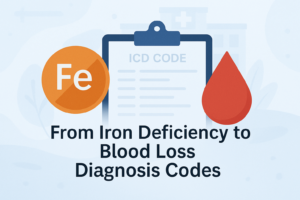Cash Flow and revenue cycle management are linked with each other. Efficient revenue means you receive timely payments for your services. In the healthcare field, RCM is the major component of each practice. Healthcare providers use RCM to monitor the payments of patients from appointments until the final payment gets paid. The global market is expected to reach $364.80 billion by 2033. As the market expands, trends also change. The strategy that worked well in 2019 won’t work anymore in the future. That’s why 2025 is the perfect time to rethink and supercharge your RCM strategy. So let’s discuss.
Importance of RCM
Revenue cycle management includes all clinical and administrative tasks that help generate, manage, and collect payment for patient services. Each stage in this revenue cycle process is important from patient registration and appointment scheduling to billing and payment collection. Not all practices have an efficient revenue process. A well-managed revenue cycle process includes accurate and timely payment of healthcare providers for rendered services. Some practices also face revenue loss due to various reasons like coding problems, rejected or denied claims, ineffective collections processes, and insufficient follow-up on outstanding amounts. These revenue losses also impact the practice’s operational effectiveness. To make this RCM process efficient, they need to follow those steps that help to save from revenue leakage.
Start with Smarter Eligibility Checks
The first thing that needs to be updated is eligibility verification. Detailed verification of patients’ eligibility and benefits is a necessary step in efficient revenue cycle management. The problem starts if you’re still relying on front-desk staff manually checking insurance via phone calls or payer portals. About 23% of the claims get denied or delayed due to eligibility issues. But in 2025 this scenario is totally changing as we have access to real-time technology.
The thing you need to do is invest in a solid eligibility verification tool that integrates with your EHR or practice management system. It should automatically verify patient coverage before the appointment in real-time. It will be more helpful if it also identifies things like copays, deductibles, or coverage limitations. This real-time verification relevant to eligibility denials is reduced by up to 68%.
Automate Wherever You Can Without Losing the Human Touch
- Real-time eligibility checks
- Claim scrubbing and submission
- Prior authorization workflows
- Patient balance notifications via text/email
- Payment posting and reconciliation
- Complex coding scenarios
- High-dollar claim follow-ups
- Appeals and denials that require detailed explanations
Get Serious About Denial Management
Denials are not necessary in each process. But what you can control is how you handle them.
Too many practices just resubmit claims without figuring out why they got denied in the first place. This is the major problem here just like fixing a leaky pipe without checking where the water’s actually coming from. To deal with these denials you need a proactive denial management plan. This management plan includes how you track denial trends, find root causes, and fix them at the source. Analyse:
- Are you seeing a pattern with coding errors?
- Missing modifiers?
- Timely filing issues?
Figure it out and address it as the first priority.
Remember that don’t wait until you’re stuck in unpaid claims. Work your denials daily or weekly, not just when someone has time. Assign dedicated staff or partner with a medical billing company that treats denials as a top priority, not an afterthought. This proactive denial management improves the overall RCM processes of your practice.
Train Your Team Like It’s a Priority
The major role played in the RCM process is your team. Humans can make errors by nature and a lot of revenue leakage comes down to human error. Not because your staff doesn’t care but because they’re not always given the right tools or training that they actually need to succeed and enhance skills. Each entity included in your practice can impact the RCM from front-desk receptionists to billing coders. So, if you’re not investing in regular training then you are actually missing your money. In 2025, make education non-negotiable. That doesn’t mean just giving PowerPoints or once-a-year compliance refreshers. It means:
- Monthly lunch-and-learns on topics like coding changes, payer updates, or how to find the major issues.
- Cross-training so team members understand the full revenue cycle, not just their piece of it
- Access to online resources, webinars, or certifications
And don’t forget your clinical team. Providers play a major role in accurate documentation and coding. If they’re not up to speed then your claims won’t be either.
Level Up Your Patient Payment Experience
The days of sending paper bills and hoping patients mail a check two weeks later are long processes. Patients are consumers now and they expect a payment experience that must be fast, easy, and digital. The payment system in 2025 looks like this:
- Text or email statements with a direct pay link
- Payment plans they can set up online
- Mobile-friendly portals where they can view balances and history
- Apple Pay, Google Pay, and HSA card support the work
To do this better you can give patients cost estimates before the visit. That way they’re not getting unknown and you’re not stuck chasing payments after the fact. Another major fact is kind and clear communication. A simple and friendly message like Hi Sarah! You have a $45 balance from your 4/15 visit. Click here to pay, it only takes a minute! Can go a long way. The easier you make it, the faster you get paid.
Monitor the Right Metrics
You can’t improve what you’re not measuring. But it does not mean tracking too many metrics or the wrong ones altogether as most of the practices generally do. In 2025, you need to focus on the metrics that matter. You want data that gives you insight and prompts action. Some of the useful RCM KPIs include:
- Days in AR (Accounts Receivable): Are you getting paid fast or sitting on unpaid claims?
- First-pass resolution rate: How many claims get paid the first time without edits?
- Denial rate: Is it going up or down? What’s causing it?
- Patient collection rate: Are patients actually paying their balances?
- Net collection rate: Are you collecting what you’re owed after adjustments?
The big thing is that you do not just track these numbers but you need to talk about them. Use them in team meetings and set goals. Identify issues.
Embrace Tech
Technology now transforms the whole field of healthcare. Different AI, machine learning, and RPA tools are available that can help you simplify your RCM operations and reduce your headaches. But don’t forget that RCM is still about people. Your patients. Your team. Your coders. Your billers. All entities are important. AI tools can handle different tasks:
- Reading and extracting data from EOBs
- Auto-coding based on documentation
- Prior auth status tracking
Remember to listen to your staff. If your new software is slowing them down or adding extra steps, it means it’s not working as you need. Choose the best RCM system in 2025 that works best in the background and helps your team enhance their skills.
Final Thoughts:
RCM is a major component of healthcare practices. If you want to make it efficient then you need a partner like M&M Claims Care. We are a medical billing company in the US and have worked for years in this industry. We understand how to make your RCM more effective and improve your cash flow. We invest in technology and training to simplify repetitive tasks and enhance the skills and knowledge of our medical billing experts.







